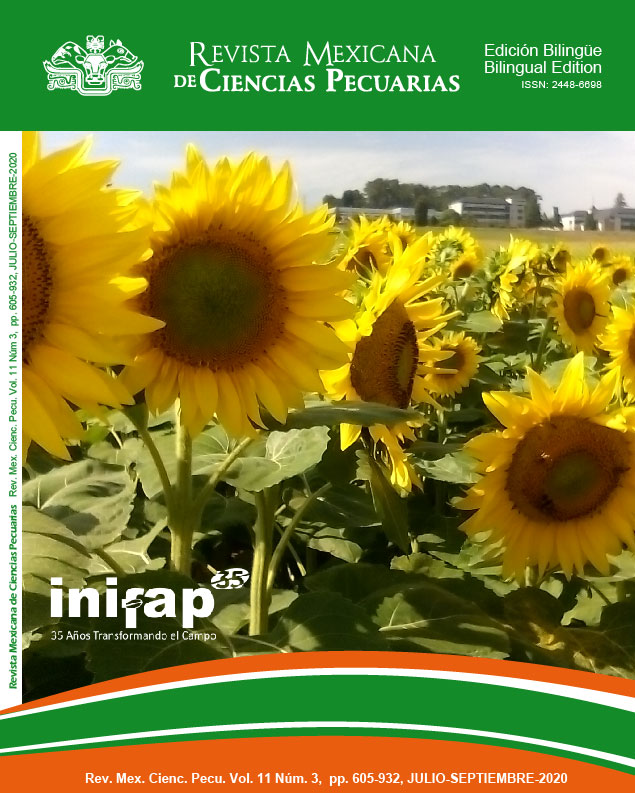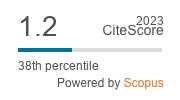Polymorphisms associated with the number of live-born piglets in sows infected with the PRRS virus in southern Sonora Mexico
DOI:
https://doi.org/10.22319/rmcp.v11i3.5002Palabras clave:
alleles, breeding sows, genotype, live-born, piglets, PRRS, SNPResumen
The porcine reproductive and respiratory syndrome (PRRS) is a viral disease that decreases the reproductive performance in breeding sows and leads to economic losses to the swine industry. The objective of the present study was to identify single nucleotide polymorphisms (SNP) associated to the number of live-born piglets in the first (LBP1) and second birth (LBP2) in breeding sows exposed to PRRS virus. The study included 100 pregnant females of the Landrace(¾)/ Yorkshire(¼) line, 75 of which were infected with the PRRS virus and 25 were free of PRRS. Individual blood samples (6-8 drops) were obtained and spotted onto FTA cards and subsequently processed for DNA extraction, which was genotyped using a 10,000 SNP chip for genomic profile. Resulting genotypes were analyzed using a multi-locus mixed model that detected three SNP associated to LBP1 and five SNP associated to LBP2 (P<0.001). These eight SNP were validated using an associative mixed effects model which included the terms genotype and age of dam as fixed effects, and sire as random effect. Allele substitution effects were estimated using the same model including the term genotype as covariate. The SNP rs81276080, rs81334603 and rs80947173 were associated to LBP1 (P<0.001), whereas the SNP rs81364943, rs80859829, rs80895640, rs80893794 and rs81245908 were associated to LBP2 (P<0.001). Only two SNP were in functional chromosomal regions and the remainder SNP were within an intergenic position. In conclusion, these results suggest the existence of gene variants associated with the reproductive performance of sows infected with the PRRS virus.
Descargas
Citas
Holtkamp DJ, Kliebenstein JB, Neumann EJ, Zimmerman JJ, Rotto HF, Yoder TK, et al. Assessment of the economic impact of porcine reproductive and respiratory syndrome virus on United States pork producers. J Swine Health Prod 2013;21(2):72–84.
Lunney JK, Steibel JP, Reecy JM, Fritz E, Rothschild MF. Probing genetic control of swine responses to PRRSV infection: current progress of the PRRS host genetics consortium. BMC Proceedings 2011;5(4):S30.
Boddicker N, Waide EH, Rowland RRR, Lunney JK, Garrick DJ, Reecy JM, et al. Evidence for a major QTL associated with hot response to Porcine Reproductive and Respiratory virus syndrome challenge. J Anim Sci 2012;90(6):1733-1746.
Milian-Suazo F, Canto-Alarcón GJ, Weimersheimer-Rubí JE, Coba-Ayala MA, Correa-Girón P, Anaya-Escalera AM. Estudio seroepidemiológico para determinar la presencia de anticuerpos contra el virus del Síndrome Disgenésico y Respiratorio del Cerdo en México. Tec Pecu Mex 1994;32(3):139-144.
Ramírez R, Sierra N, Mota D. Aislamiento del virus de PRRS en México: Estudio clínico, serológico y virológico. Arch Med 2000;32(1):1-9.
Lewis CR, Ait-Ali T, Clapperton M, Archibald AL, Bishop, S. Genetic perspectives on host responses to porcine reproductive and respiratory syndrome (PRRS). Viral Immunol 2007;20(3):343-358.
Mateu E, Diaz I. The challenge of PRRS immunology. Vet J 2008;177(3):345-351.
Royaee AR, Husmann RJ, Dawson HD, Calzadanova G, Schnitzlein WM, Zuckermann A. Deciphering the involvement of innate immune factors in the development of the host response to PRRSV vaccination. Vet Immunol Immunopathol 2004;102(3):199-216.
Reiner G. Genetic resistance - an alternative for controlling PRRS?. Porcine Health Manag 2016;2(27):1-11.
Georges M. Mapping, fine mapping, and molecular dissection of quantitative trait loci in domestic animals. Annu Rev Genomics Hum Genet 2007;8:131-162.
Muñoz G, Ovilo C, Estellé J, Fernández A, Rodríguez C. Association with litter size of new polymorphisms on ESR1 and ESR2 genes in a Chinese-European pig line. Genet Sel Evol 2007;39(2):195-206.
Goddard ME, Hayes BJ. Genomic selection. J. Anim. Breed. Genet 2007;124(6):323-330.
Long Y, Ruan GR, Su Y, Xiao SJ, Zhan ZY, Ren J, et al. Genome-wide association study identifies QTLs for EBV of backfat thickness and average daily gain in Duroc pigs. Genetika 2015;51(3):371-378.
Abella G, Pena R, Nogareda C, Armengol R, Vidal A, Moradell L, et al. A WUR SNP is associated with European Porcine Reproductive and Respiratory Virus Syndrome resistance and growth performance in pigs. Res Vet Sci 2016;104:117–122.
Rashidi H, Mulder HA, Mathur P, van Arendonk JAM, Knol EF. Variation among sows in response to porcine reproductive and respiratory syndrome. J Anim Sci 2014;92(1):95–105.
Halbur PG, Rothschild MF, Thacker BJ, Meng X-J. Paul PS, Bruna JD. Differences in susceptibility of Duroc, Hampshire, and Meishan pigs to infection with a high virulence strain (VR2385) of porcine reproductive and respiratory syndrome virus (PRRSV). J Anim Breed Genet 1998;115:181–189.
Petry DB, Holl JW, Weber JS, Doster AR, Osorio FA, Johnson RK. Biological responses to porcine respiratory and reproductive syndrome virus in pigs of two genetic popula¬tions. J Anim Sci 2007;83(7):1494–1502.
Purcell S, Neale B, Todd-Brown K, Thomas L, Ferreira MA, Bender D, et al. PLINK: a tool set for whole-genome association and population-based linkage analyses. Am J Hum Genet 2007;81(3):559–575.
Littell, R, Stroup W, Freund R. SAS for linear models. 4th ed. SAS Institute Inc., Cary, NC. 2002.
Saxton AM, Balzarini MG, Cappio-Borlino A, Czika W, Fry JD, Gibson G, et al. Genetic analysis of complex traits using SAS. SAS Institute, Inc., North Carolina; 2004.
Sherman EL, Nkrumah JD, Murdoch BM, Li C, Wang Z, Fu A, et al. Polymorphisms and haplotypes in the bovine neuropeptide Y, growth hormone receptor, ghrelin, insulin–like growth factor 2, and uncoupling proteins 2 and 3 genes and their associations with measures of growth, performance, feed efficiency, and carcass merit in beef cattle. J Anim Sci 2008;86(1):11–16.
Lewis CRG, Torremorell M, Bishop SC. Effects of porcine reproductive and respiratory syndrome virus infection on the performance of commercial sows and gilts of different parities and genetic lines. J Swine Health Prod 2009;17(3):140–147.
Lewis CRG, Torremorell M, Galina-Pantoja L, Bishop SC. Genetic parameters for performance traits in commercial sows estimated before and after an outbreak of porcine
reproductive and respiratory syndrome. J Anim Sci 2009;87(3):876–884.
Lewis CR, Ait-Ali T, Clapperton M, Archibald AL, Bishop S. Genetic perspectives on host responses to porcine reproductive and respiratory syndrome (PRRS). Viral Immunol 2007;20(3):343-358.
Serão NV, Matika O, Kemp RA, Harding JC, Bishop SC, Plastow GS, et al. Genetic analysis of reproductive traits and antibody response in a PRRS outbreak herd. J Anim Sci 2014;92(7):2905–2921.
Balding DJ. A tutorial on statistical methods for population association studies. Nat Reviews 2006;7(10):781–791.
Seibert JT, Graves KL, Hale BJ, Keating AF, Baumgard LH, Ross JW. Characterizing the acute heat stress response in gilts: I. Thermoregulatory and production variables. J Anim Sci 2018;3(96):941-949.
Umemura M, Fujita M, Yoko-O T, Fukamizu A, Jigami Y. Saccharomyces cerevisiae CWH43 is involved in the remodeling of the lipid moiety of GPI anchors to ceramides. Mol Biol Cel. 2007;18(11):4304-4316.
Ghugtyal V, Vionnet C, Roubaty C, Conzelmann A. CWH43 is required for the introduction of ceramides into GPI anchors in Saccharomyces cerevisiae. 2007;65(6):1493-1502.
Abo-Ismail MK, Brito LF, Miller SP, Sargolzaei M, Grossi DA, Moore SS, et al. Genome-wide association studies and genomic prediction of breeding values for calving performance and body conformation traits in Holstein cattle. Genet Sel Evol 2017;49(1):49–82.
Miller LC, Fleming D, Arbogast A, Bayles DO, Guo B, Lager KM, et al. Analysis of the swine tracheobronchial lymph node transcriptomic response to infection with a Chinese highly pathogenic strain of porcine reproductive and respiratory syndrome virus. BMC Vet Res 2012;8(1):208.
De Clercq E, Murase J, Marquez VE. Broad-spectrum antiviral and cytocidal activity of cyclopentenylcytosine, a carbocyclic nucleoside targeted at CTP synthetase. Biochem Pharmacol 1991;41(12):1821–1829.
Veroneze R, Bastiaansen JW, Knol EF, Guimarães SE, Silva FF, Harlizius B, et al. Linkage disequilibrium patterns and persistence of phase in purebred and crossbred pig (Sus scrofa) populations. BMC Genet 2014;15(1):126.
Bergfelder-Drüing S, Grosse-Brinkhaus C, Lind B, Erbe M, Schellander K, Simianer H, et al. A genome-wide association study in large white and landrace pig populations for number piglets born alive. PloS ONE 2015;10(3):e0117468.
Kimble K. Transcriptome profiles of porcine oocytes and their corresponding cumulus cells reveal functional gene regulatory networks [masters thesis]. Alabama, USA: Auburn University; 2018.
Russell DL, Brown HM, Dunning KR. ADAMTS proteases in fertility. Matrix Biol 2015;44(46):54–63.
Llamazares M, Cal S, Quesada V, López-Otín C. Identification and characterization of ADAMTS-20 defines a novel subfamily of metalloproteinases-disintegrins with multiple thrombospondin-1 repeats and a unique GON-domain. J Biol Chem 2003;278(15):13382–13389.
Sur JH, Doster AR, Christian JS, Galeota JA, Wills RW, Zimmerman JJ, et al. Porcine reproductive and respiratory syndrome virus replicates in testicular germ cells, alters spermatogenesis, and induces germ cell death by apoptosis. J Virol 1997;71(12):9170–9179.
Chen J, Shi X, Zhang X, Wang A, Wang L, Yang Y, et al. MicroRNA-373 facilitated the replication of porcine reproductive and respiratory syndrome virus (PRRSV) by its negative regulation of type I interferon induction. J Virol 2016; JVI-01311.
Noguera JL, Rodríguez C, Varona L, Tomás A, Muñoz G, Ramírez O, et al. A bi-dimensional genome scan for prolificacy traits in pigs shows the existence of multiple epistatic QTL. BMC Genomics 2009;10(1):636.
Fernandez-Rodriguez A, Munoz M, Fernandez A, Pena RN, Tomas A, Noguera JL, et al.
Differential gene expression in ovaries of pregnant pigs with high and low prolificacy levels and identification of candidate genes for litter size. Biol Reprod 2011;84(2):299–307.
Chen X, Zhang Q, Bai J, Zhao Y, Wang X, Wang H, et al. The nucleocapsid protein and non-structural protein 10 of highly pathogenic porcine reproductive and respiratory syndrome virus enhance CD83 production via NF-κB and Sp1 signaling pathways. J Virol 2017;JVI-00986.
Nakamura N. The role of the transmembrane RING finger proteins in cellular and organelle function. Membranes 2011;1(4):354–393.
Chen XX, Quan R, Guo XK, Gao L, Shi J, Feng WH. Up-regulation of pro-inflammatory factors by HP-PRRSV infection in microglia: implications for HP-PRRSV neuropathogenesis. Vet Microbiol 2014;170(1):48–57.
Katoh Y, Katoh M. Comparative integromics on FAT1, FAT2, FAT3 and FAT4. Int J Mol Med 2006;18(3):523–528.
Balakrishnan B, Johnson RW. Altered brain development in fetal and neonatal piglets following maternal porcine respiratory and reproductive syndrome virus (PRRSV) infection. Brain Behav Immun 2015;49:e31.
Descargas
Publicado
Cómo citar
-
Resumen830
-
PDF424
-
PDF 255
-
Full text 76
Número
Sección
Licencia
Los autores/as que publiquen en la Revista Mexicana de Ciencias Pecuarias aceptan las siguientes condiciones:
De acuerdo con la legislación de derechos de autor, la Revista Mexicana de Ciencias Pecuarias reconoce y respeta el derecho moral de los autores/as, así como la titularidad del derecho patrimonial, el cual será cedido a la revista para su difusión en acceso abierto.

Esta obra está bajo una Licencia Creative Commons Atribución-NoComercial-CompartirIgual 4.0 Internacional.





